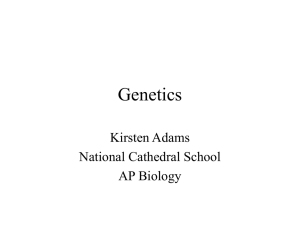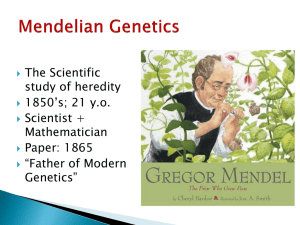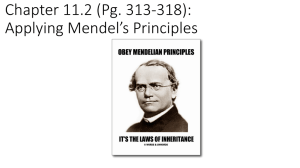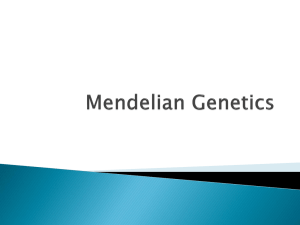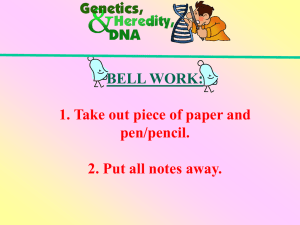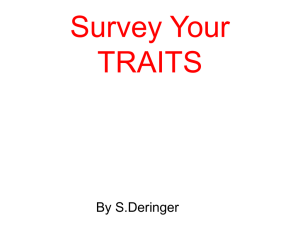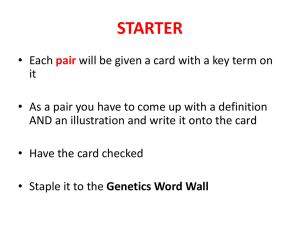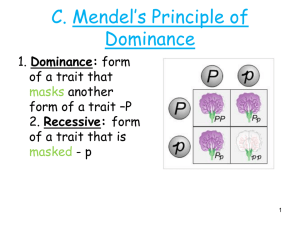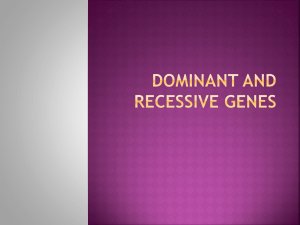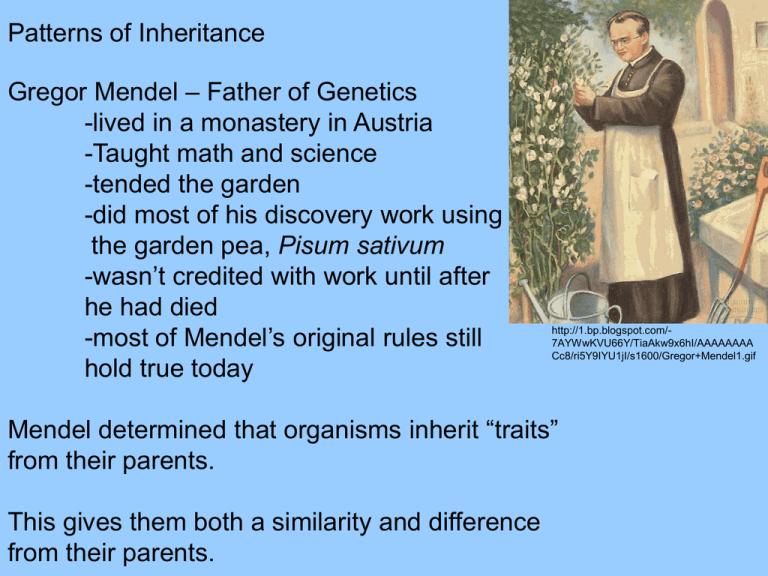
Patterns of Inheritance
Gregor Mendel – Father of Genetics
-lived in a monastery in Austria
-Taught math and science
-tended the garden
-did most of his discovery work using
the garden pea, Pisum sativum
-wasn’t credited with work until after
he had died
-most of Mendel’s original rules still
hold true today
http://1.bp.blogspot.com/7AYWwKVU66Y/TiaAkw9x6hI/AAAAAAAA
Cc8/ri5Y9IYU1jI/s1600/Gregor+Mendel1.gif
Mendel determined that organisms inherit “traits”
from their parents.
This gives them both a similarity and difference
from their parents.
Genes (locus) actually consist of two different parts
called ALLELES…
2 alleles make a gene and one gene can determine a
trait.
One allele comes from each parent on the gametes
passed down during fertilization of an egg by a sperm.
Alleles will be either
DOMINANT or RECESSIVE
dominant alleles always
appear and mask out the
recessive alleles.
recessive alleles must
be purely recessive in
order to appear.
http://www.bio.georgiasouthern.edu/bio-home/harvey/lect/images/alleles.gif
If recessive alleles must be pure in order to appear,
then that means they are HOMOZYGOUS in their
make-up. Homozygous genes are either purely
dominant or purely recessive. We say this is a “true
breeding” gene for a trait. Recessive traits can only
show up this way because there are no dominant traits
to mask them out if they are homozygous.
AA dominant
or
aa recessive
Sometimes, a dominant trait will appear by will be
HETEROZYGOUS dominant instead. This means the
gene contains one dominant allele and one recessive
allele. It appears dominant because the dominant allele
masks out the recessive allele, however, the recessive
allele may show up again in future generations.
Aa
Alleles will give an organism both their outward looks
and their genetic make-up on the genes.
PHENOTYPE is the outward appearance of the
organism. This is a result of the gene being translated
into proteins or other molecules that end up becoming
your hair color, skin type, eye color, length of your big
toe and zillions of other traits that are uniquely you.
When you observe brown eyes, blonde hair or freckles
on someone you are seeing the phenotype of that
individual.
GENOTYPE is responsible for creating the phenotype.
The genotype is the actual message on the gene (DNA)
that tells the cells what type of protein they will be made
of.
This message results in eye color, hair color, etc.
You cannot see the genotype…it is inside the genes in
your cells.
We can use information from these terms to predict an
organism’s offspring outcome.
For instance…if a homozygous tall pea crosses with a
homozygous short pea, what will the offspring look
like?
Well…it depends on which is the dominant trait and
which is the recessive trait.
When the dominant trait is determined, is it heterozygous
dominant or homozygous dominant?
What about the recessive trait???
http://www.glencoe.com/qe/images/b136/q4315/ch10_0_h.gif
P1 represents the
parent generation of
pea plants. F1
represents the first
generation and F2 the
second generation.
Based on the F1
generation being all tall
plants, do you think
the parents are
heterozygous or
homozygous for their
traits?
Still having a hard
time?
At this point…a PUNNET SQUARE would be a nice tool
to introduce. Created by R.C. Punnet who was a
poultry geneticist.
Gamete 2
Notice how
the top and
side of each
square only
lists a single
parent’s
gametes.
WHY?
Gamete 1
Gamete 1
http://feistyhome.phpwebhosting.com/punnett.gif
Gamete 2
Remember that meiosis produces haploid numbers of
chromosomes in the sperm and egg cells (gametes). That means
that even though each gene contains 2 alleles, only one of those
alleles will be passed on during reproduction by each parent.
Thus, we separate the parental gametes in order to produce
offspring that have the normal 2 alleles per gene. Each offspring
has it’s own unique combination of alleles, so chance has no
memory in genetics and all offspring have equal chances of
getting all the traits.
http://anthro.palomar.edu/biobasis/images/meiosis.gif
Adding the gametes from our pea plant parents (P1 generation)
gives us the following possible combinations for the F1 offspring…
T
t
t
Tt
Tt
T
Tt
Tt
What do the pea
plant offspring
look like?
Are they tall or
short?
Homozygous or
heterozygous?
Can you
determine the
ratios for the
offspring?
What do the
ratios tell you?
http://feistyhome.phpwebhosting.com/punnett.gif
This punnet square shows the resulting offspring from a
cross between two of the F1 generation.
They are called the F2 generation.
What are the genotype and phenotype ratios?
Are they the same as the F1 generation ratios?
http://creationwiki.org/pool/images/thumb/3/3b/Punnett_square.JPG/200px-Punnett_square.JPG
http://www.exploringnature.org/graphics/anatomy/Punnetts_square.jpg
These punnet squares only represent MONOHYBRID or
one trait crosses. In reality, it is never this simple. Most
crosses deal with multiple genes requiring multiple
squares on the punnet.
These crosses are called
DIHYBRID,
TRIHYBRID
AND SO FORTH…
Notice that there is
still only one allele
for each trait from
each parent.
Also notice there are
16 possible offspring in
this cross, not 4.
http://image.tutorvista.com/content/feed/u2044/Punnet%20square.gif
Can you work this dihybrid cross and determine the
offspring genotype and phenotype ratios?
Just as we can have chromosomal disorders, we can
also have genetic disorders. Instead of having an
abnormal number, though, we deal with dominant and
recessive alleles instead.
DOMINANT DISORDERS: (p. 151, Table 9.1)
-tend to run in families and are very difficult to mask
out.
-alleles can either be homo- or heterozygous.
Examples:
Neurofibromatosis (NF)—
**1/2500
**benign tumors on body
**begin as coffee colored spots
in childhood
Huntington’s disease…strikes the nervous system causing
uncontrollable movements and mental deterioration.
**1/25,000
**strikes in middle age.
Alzheimer’s disease (one type)
Achondroplasia…dwarfism
strikes 1/25,000
www.sciencemuseum.org.uk/e
xhibitions/genes/196.asp
RECESSIVE DISORDERS:
-very easy to mask out
-must be homozygous to appear
-tend to be found in races and
populations where close
relatives marry
EXAMPLES:
Cystic Fibrosis…excess mucus in lungs, digestive
tract and liver, prevents digestion, pneumonia in
lungs; affects 1/1,800 European Americans
Sickle-cell disease…abnormally shaped red blood
cells, cause damage to many tissues; affects
1/500 African Americans
PKU (Phynylketonuria)…inability of the body to
breakdown phenylalanine (aa); 1/10,000 US and Europe
severe retardation in untreated cases, hospital test on newborns
Albinism—lack of pigment in skin, hair and eyes
*true albinos have colorless eyes
*white hair
*highly susceptible to skin cancer due to sun exposure
*1/22,000 occurrence
White moose
seen in
northern
Michigan.
IF ONLY….
GENETICS WERE ALWAYS THIS EASY
TO UNDERSTAND???@@@###$$$
THERE ARE always EXCEPTIONS TO THE RULES!!
Beyond Mendel we have some genetic phenomenon
that doesn’t play by the rules:
INCOMPLETE DOMINANCE—traits are both dominant
and unable to mask each other out so
resulting offspring have an appearance that is a
“blending” of each parent. (NOT
blending theory)
Red x White Snapdragons = Pink
offspring
Hypercholesterolemia = high
blood pressure
HH = normal bp, hh = severely
high bp (1/1mil)
Hh = bp about 2x normal (1/500)
CO-DOMINANCE—offspring will show both dominant
characteristics of parents. Traits are unable to
mask each other out so they both show up.
Black/White face cattle and A/B blood type
MULTIPLE ALLELES—some traits have more than 2
(i.e. dom/rec) that code for them. Only 2 of the
multiple alleles can be on a gene at a time.
Blood type in humans is a good example. (p. 156, F 9.20)
Have 3 alleles for blood type:
A is dom, B is dom, “O” is rec or “zero”
These code for several types of blood:
AA, AO are both type “A”
BB, BO are both type “B”
AB and OO (type O).
Blood can only be infused with a compatible type. Only
A can infuse A, Only B can infuse B, Only AB can
infuse AB and Only O can infuse O. Since O is recessive
is considered a universal infuser. It can infuse all types.
PLEITROPHY—one gene can influence many inherited
characteristics. Usually only one gene influences one
characteristic.
Examples:
Sickle-cell disease—gene to make a
normal shape of red blood cell is
missing. “Half moon” shaped red
blood cells cause many problems;
anemia, joint pain, spleen damage,
heart damage, brain damage, weakness
Marfan’s Syndrome—gene to make normal
connective tissue in muscle is missing.
Causes tallness, long fingers and toes, heart
has weak aorta wall and can rupture.
POLYGENETIC INHERITANCE—one trait is controlled
by more than one gene.
Example:
Skin color in humans:
controlled by 3 genes
A, B, and C
AABBCC is darkest skin color
aabbcc is albinism
AaBbCc or any variation of
½ dom and ½ rec alleles is
medium skin.
Environment can affect skin color (and many other traits)
as much as genetics do. Some people with lighter skin
genetics appear dark due to the sun or tanning beds.
Height is affected by hormones, nutrition in early years.
Heart disease is both genetic and environmental.
SOME DISORDERS ARE CARRIED ONLY ON THE
SEX CHROMOSOMES, X and Y. These disorders are
called SEX-LINKED DISORDERS:
Red-green colorblindness good example.
Can you see the
shapes in this
diagram?
If not,
you may be
color-blind. More
men than women
are affected because
it is carried on the “X”
chromosome and
males cannot mask it out with a normal X like women can

